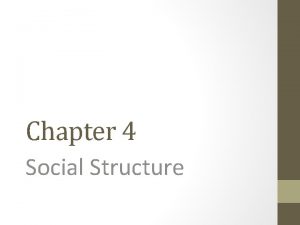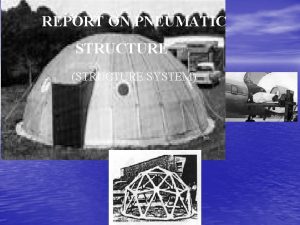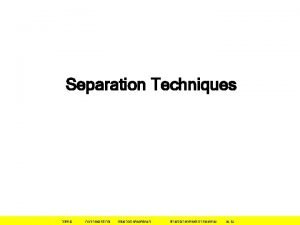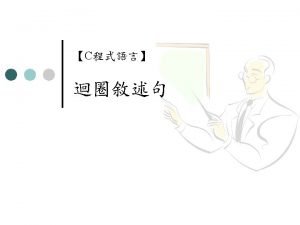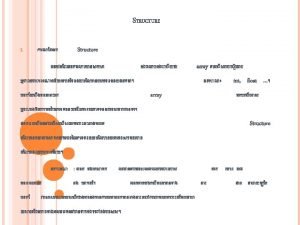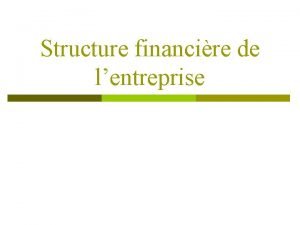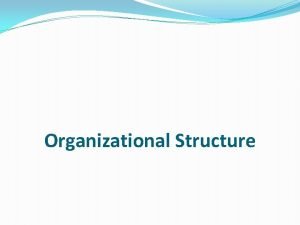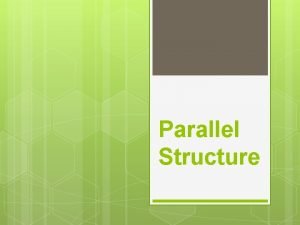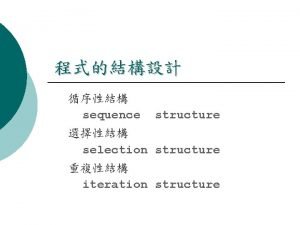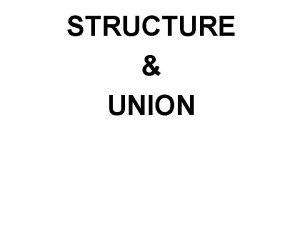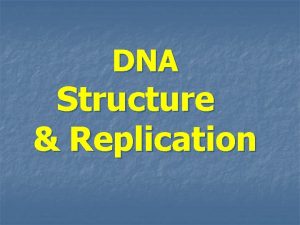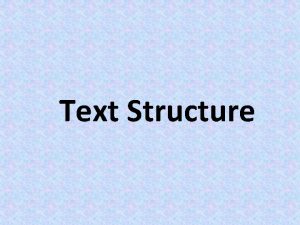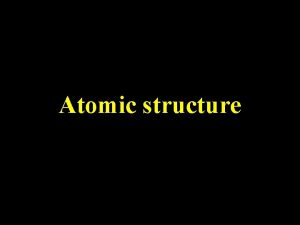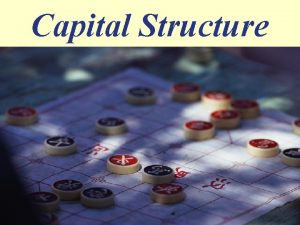Information Structure Information Structure The information structure of































- Slides: 31

Information Structure

Information Structure The information structure of a sentence consists of two parts, one more informative and one less informative. The contrast is either marked by word order or by intonation. For example, the more informative part is generally believed to follow the less informative part (often referred to as theme-rheme or topic-comment structure). Or the most prominent intonational feature, the pitch accent, is correlated with the most informative part, while the rest of the sentence is less informative (often referred to as focus-background partition).

Linearization Problem One of the constrain on the speaker/writer is that he can produce only one word at a time. When he orders these single words into sentences, and these sentences into texts, he confronts what has come to be called the linearization problem. Example: S 1: I can’t stand Sally Bins. She’s tall and thin and walks like a crane. S 2: I do admire Sally Bins. She’s tall and thin and walks like a crane.

Linearization Problem So, this is the intention of the speaker/ writer which determines which constituent should be ordered first. The information that is provided at the beginning is based on what speaker thinks you know or don’t know about what he is going to say. Discourse (verbal exchange of ideas) is distributed into information units. Example: 1) She married and got pregnant. 2) She got pregnant and married.

Theme and Rheme It deals with thematic organization in a clause or sentence. Theme, refers to a formal category, the left most constituent of the sentence. Each simple sentence has a theme “ the starting point of the utterance” and a “rheme”, “ everything else that follows in the sentence which consists of “ what the speaker states about, or in regard to, the starting point of the utterance”. The theme, then, is what speakers/ writers use as a “point of departure”. In many cases (often considered to be the unmarked or neutral cases).

Theme and Rheme The theme of declarative sentences will be a noun phrase (the grammatical subject), that of interrogatives the interrogative word, and that of imperatives the imperative form of the verb. Example: John saw the play yesterday.

Theme and Rheme Different forms for the same propositional: It is the case in most languages. A) John loves Mary. B) Mary was loved by John. C) It was John who loved Mary. by John. D)It was Mary who was loved E)What John did was to love Mary. F) Who John loved was Mary. G) Mary, John loved her. The reason for this variety of forms maybe that the more marked a sentence, the more it is intended to convey an implicated meaning.

Theme and Rheme From the discourse analyst’s point of view, the most wide ranging and interesting approach must be that which considers the effect of using one sentential form rather than another in the context of discourse. It is clearly the case that pervious examples could not all function satisfactorily as answers to the same question. A speaker producing these utterances would have different assumptions about the state of knowledge of his hearer, that is about his hearer’s presuppositions.

Theme and Rheme With simple examples like these, it seems reasonable to suggest that what is primarily at issue is the judgment that the speaker makes about what the hearer believes to be the case with respect to what he wants to talk about. Example: A) The Prime Minister stepped off the plane. B) Journalists surrounded her. C) She was Surrounded by journalists. There is a preference for C as the continuation sentence, rather than B. This is because readers prefer to maintain the same subject (or discourse topic entity)

Non-Subject Themes Many times theme and grammatical subject conflate, but it is important to note that the left most constituent, is not always the grammatical subject. It is frequently the case, for instance, in declarative sentences, that adverbs or adverbial phrases may precede the grammatical subject as in: A) Late that afternoon, she received a reply paid telegram B) Then he went on C) Without hesitating Betty replied

Thematization In general, it seems reasonable to suggest that the constituent which is thematized in a sentence is what the sentence is about. Example: A) Fred borrowed a hammer from John. B) John lent a hammer to Fred. Sentence (A) seems to be “about” Fred and (B) seems to be “about” John.

Thematization Theme has two main functions: 1) Connecting back and linking into the pervious discourse, maintaining a coherent point of view. 2) Serving as a point of departure for the further development of the discourse.

Given and New English like many other languages shows a tendency to order given information before new information in an utterance Chafe (1976) defines given information as “that knowledge which the speaker assumes to be in the consciousness of the addressee at the time of the utterance. ” while new information is defined as “what the speaker assumes he is introducing into the addressee’s consciousness by what he says.

Given and New The sentence has a bi-partite structure and the function of the choice as to what information we put in each part is to enable us to bring different bits of information to different degrees of prominence. One explanation is that the sender hypothesizes about what the receiver does know or doesn't is important. Based on this, we might divide information into two types: 1) What the sender thinks the receiver already knows. (Given Information) 2) What the receiver doesn’t already know. (New Information) Any unit of information of a sentence, may change the status of discourse that proceeds'. It might be new in one and given in the next.

Given and New Communication can therefore be defined as the conversion of new information into given information and a successful communicator can assess the state of knowledge of his interlocutors. If we misjudge given as new, we will be boring, in the reverse case, we can be incomprehensible. A typical discourse then proceeds as: Given New, …. . .

Given and New A boundary between the two types of information may well coincide with the boundary of a language unit sentence, clause or phrase. Example: like a biography Earnest Hemingway : Ernest Miller Hemingway is born in Oak Park, Illinois, a place he will later describe as a town of "wide lawns and narrow minds. " He is the second of six children of Clarence Hemingway, a doctor, and Grace Hall Hemingway, a music teacher. From his infancy, Hemingway's mother begins a strange habit of dressing her son like a girl, complete with dresses and long hair, and his older sister as a boy, with overalls and cropped hair. ……….

Psychology Of Given and New Information This bi-partite structure may reflect the way the sender has organized information in his own mind, more than the way he guesses it is another persons’ mind, or the sender may wish to make certain parts of the message the “topic” and others simply “comments”. One thing is certain: The choices about the order of information reveals our own assumption about the world and the people who we are trying to communicate with. The truth of these assumption gives unity and coherence to our discourse.

Textual Analysis: Thematic Organization Textual analysis refers to the anatomical description of a text in terms of its textual features or texture by adopting particular approach to analysis. That is, the texture of a text can be characterized by identifying discourse markers (e. g. , text connectors or cohesive ties), metadiscourse markers(e. g. , hedge boosters, endophoric markers etc. ), thematic patterns or Thematization, and textual schematic structure. Thematic organization: It refers to how theme and rheme are organized for the text development.

Unmarked vs. Marked Theme It frequently happens that theme in clause coincides with the subject. If this happens, we have an unmarked theme, such as Ali in this sentence: Ali bought a new house. But it is also possible to have another constituent placed initially in a clause. If this is the case, we have a marked theme. For example: In 1998, Ali bought a new house. The rationale for dividing theme into marked and unmarked is that the default mode for representing information in a clause is theme followed by the rheme. The theme is the point of departure of message and oriented towards the writer/ speaker, which means this is how I want to start my message.

Unmarked vs. Marked Theme The rheme contains the message’s point of focus and is oriented towards the reader/listener, which means this is what I want you to pay attention to. Any change in this order (theme- rheme) will create a different thematic organization which results in different methods of development.

What is Thematic progression (TP)? Thematic Progression (TP) is a method of development of a text created through the author’s choice of theme. The choice of themes in a passage follows certain patterns. These patterns produce different types of Thematic Progression regards how utterances link up to one another and make the text progress. Thematic Progression contributes to the production of text convexity. Thematic Progression facilitates the reading process.

What do linguists say? Halliday: The choice of clause themes plays a fundamental part in the way discourse is organized; it is this, in fact, which constitutes what has been called the “method of development” of the text. Danes : Our basic assumption is that text convexity is represented … by thematic progression (TP). By this term we mean the choice and ordering of utterance themes … Thematic progression might be viewed as the skeleton of the plot.

Thematic Progression It refers to the way in which theme of a clause may pickup or repeat a meaning from a preceding theme and rheme. There at least three kinds of thematic development patterns as follows: Theme reiteration/constant theme pattern Zigzag/linear theme pattern Multiple/split rheme pattern

(A) Theme Reiteration/ Constant Theme Pattern This pattern shows that the first theme is picked up and repeated in the beginning of the next clause. This pattern can be represented as follow: THEME 1 RHEME 1 THEME 2 RHEME 2 THEME 3 RHEME 3 Ali is a teacher. He teaches English. He lives in Tehran.

(A) Theme Reiteration/ Constant Theme Pattern The same theme (but not necessarily exactly the same words) appears in a series of utterances and different rhemes are linked up to it. Constant theme pattern is frequently used when characters in a story are developed The continuous, constant theme may be a place, a time, or a concept, about which the reader is informed through the relative rhemes. The progression is a sort of expansion on a specific topic (theme) which allows the reader to concentrate on one specific topic to which different pieces of new information are gradually added.

(B) A Zig-Zag / Linear Theme Pattern It is a pattern when the subject matter in the rheme of one clause is taken up in theme of the following clause. The zig- zag pattern can be represented as follows: THEME 1 RHEME 1 THEME 2 RHEME 2 THEME 3 RHEME 3 Ali has a new book. It is on the brown desk. The desk is in his room.

(B) A Zig-Zag / Linear Theme Pattern This linear progression is the most elementary, basic TP that produces a highly cohesive text. It uses the ‘news’ of one utterance (rheme or part of the rheme) immediately as the point of departure for the following utterance. Linear theme pattern develops a ‘step-wise’ structure. This is useful for child readers because it facilitates the processing of new information by giving an anchorage from which to start.

(C ) Multiple theme/ Split Rheme Pattern In this pattern, a rheme may include a number of different pieces of information, each of which may be taken up as theme in a number of sequent clauses. The zig-zag pattern can be presented as follows: John has a car, a house and a villa. The car is brown. The house is in New York. The villa is huge.

(C ) Multiple theme/ Split Rheme Pattern The hyper-theme is a sort of general topic. The hyper-theme is expanded through the subthemes (T¹T²T³) linked to it. The subthemes take up some part of this general topic. Each derived theme (or subtheme) is linked to a rheme which gives new information about the particular aspect introduced. TP 3 is frequently used in descriptions of places, where one particular place is the hyper-theme and different parts of that particular place are then described. This procedure allows the reader to get to know the setting gradually.

Thematic Progression helps give cohesion and thus coherence to a text, guiding the reader through the text in a logical and rational course. This aspect of textual strategy has an important role particularly in stories for children, who are inexperienced readers. Ekvist (1975: A sentence might be compared to a piece of flex with plugs at either end, and these plugs have to connect with corresponding plugs at the end of neighboring sentences. Taking up this metaphor, we may say that unless the child’s mind is ‘plugged in’ correctly, s/he will find it complicated to unravel the mass of information offered in a story.

Thematic Progression These patterns are tendencies rather than absolutes. They can shape styles. Very few texts, repeated the same thematizating patterns endlessly. (Repeating pattern may shows the elementary level problem in writing).
 Hình ảnh bộ gõ cơ thể búng tay
Hình ảnh bộ gõ cơ thể búng tay Slidetodoc
Slidetodoc Bổ thể
Bổ thể Tỉ lệ cơ thể trẻ em
Tỉ lệ cơ thể trẻ em Chó sói
Chó sói Chụp phim tư thế worms-breton
Chụp phim tư thế worms-breton Hát lên người ơi alleluia
Hát lên người ơi alleluia Các môn thể thao bắt đầu bằng tiếng đua
Các môn thể thao bắt đầu bằng tiếng đua Thế nào là hệ số cao nhất
Thế nào là hệ số cao nhất Các châu lục và đại dương trên thế giới
Các châu lục và đại dương trên thế giới Công thức tính độ biến thiên đông lượng
Công thức tính độ biến thiên đông lượng Trời xanh đây là của chúng ta thể thơ
Trời xanh đây là của chúng ta thể thơ Mật thư anh em như thể tay chân
Mật thư anh em như thể tay chân Làm thế nào để 102-1=99
Làm thế nào để 102-1=99 Phản ứng thế ankan
Phản ứng thế ankan Các châu lục và đại dương trên thế giới
Các châu lục và đại dương trên thế giới Thể thơ truyền thống
Thể thơ truyền thống Quá trình desamine hóa có thể tạo ra
Quá trình desamine hóa có thể tạo ra Một số thể thơ truyền thống
Một số thể thơ truyền thống Cái miệng nó xinh thế chỉ nói điều hay thôi
Cái miệng nó xinh thế chỉ nói điều hay thôi Vẽ hình chiếu vuông góc của vật thể sau
Vẽ hình chiếu vuông góc của vật thể sau Thế nào là sự mỏi cơ
Thế nào là sự mỏi cơ đặc điểm cơ thể của người tối cổ
đặc điểm cơ thể của người tối cổ Ví dụ về giọng cùng tên
Ví dụ về giọng cùng tên Vẽ hình chiếu đứng bằng cạnh của vật thể
Vẽ hình chiếu đứng bằng cạnh của vật thể Vẽ hình chiếu vuông góc của vật thể sau
Vẽ hình chiếu vuông góc của vật thể sau Thẻ vin
Thẻ vin đại từ thay thế
đại từ thay thế điện thế nghỉ
điện thế nghỉ Tư thế ngồi viết
Tư thế ngồi viết Diễn thế sinh thái là
Diễn thế sinh thái là Dạng đột biến một nhiễm là
Dạng đột biến một nhiễm là




































